Spatial Downscaling of NPP-VIIRS Nighttime Light Data Using Multiscale Geographically Weighted Regression and Multi-Source Variables
Abstract
1. Introduction
2. Study Area and Data
2.1. Study Area
2.2. Data Description
- (1)
- The NPP-VIIRS monthly cloud-free DNB composite data from September 2018 was downloaded from the Earth Observation Group, Payne Institute for Public Policy, Colorado School of Mines (https://eogdata.mines.edu/download_dnb_composites.html, accessed on 1 April 2022) [53,54]. The observations impacted by lightning, lunar illumination, and stray light were pre-corrected, and the cloud cover was filtered. The monthly NTL series is run globally using two different configurations [53,55]. The first excludes any data impacted by stray light. The second includes these data if the radiance values have undergone the stray-light correction procedure. Here we have chosen the former because our study area is at a low latitude and is less affected by stray light from the poles, and the corrected data are of lower quality. The spatial resolution of the data is 500 m.
- (2)
- The LuoJia1-01 image was utilized to verify the downscaled NTL data as it has a comparable spectral range to that of the NPP-VIIRS NTL output (Table 2). The LuoJia1-01 images offer a higher spatial resolution and a wider spectral range than the NPP-VIIRS NTL data, further enabling applications at a finer scale [56,57]. The geometric corrected LuoJia1-01 NTL data employed in the study have a resolution of 130 m and were collected from the high-resolution Earth Observation System of Hubei Data and Application Center High Score Tube Platform (http://www.hbeos.org.cn, accessed on 1 April 2022). To avoid the cloud cover noise in LuoJia1-01 data, we screened the cloud-free September 2018 data according to the recorded weather conditions and calculated the average value as the true NTL value. We used bilinear interpolation to resample the data at a resolution of 120 m.
- (3)
- Landsat 8 data were obtained from the United States Geological Survey (USGS) Earth Explorer website (https://earthexplorer.usgs.gov/, accessed on 10 April 2022) to calculate the NDVI, NDBI, and LST for extracting surface cover features. There are two sensors on Landsat 8: Operational Land Imager (OLI) and Thermal Infrared Sensor (TIRS), which include 11 spectral bands (9 OLI and 2 TIRS bands) (Table 2). To ensure clear imagery, we selected Landsat 8 OLI/TIRS imagery with less than 1.5% cloud cover from August–September 2018 [58].
- (4)
- The Chinese Academy of Sciences Resource and Environmental Science and Statistics Center (https://www.resdc.cn, accessed on 10 April 2022) provided the road network and LUCC data, which can distinguish the ground cover. For the provided road network vector data, we calculated the road density by constructing a 30 m × 30 m regular grid to generate a road density map with a 30-m resolution. LUCC data were generated using Landsat 8 data through visual interpretation. The LUCC data comprise 30-m resolution raster data and include six land categories: cultivated land, forest land, grassland, water area, unused land, and construction land.
- (5)
- POI represents various functional facilities in a city from a spatial perspective, such as the government, schools, offices, shopping malls, and banks. POI includes attribute and point location information, such as the name, category, longitude, and latitude. It has a large data volume, timeliness, wide-coverage, easy access, and a high level of accuracy [51]. As a feature that provides various city services, POI exists in real-time, is continuously updated for each area, and can describe the current regional functions and attributes of cities [56]. In this study, POI data were obtained from the Baidu API interface (http://lbsyun.baidu.com, accessed on 10 April 2022).
3. Methods
- (a)
- Data preprocessing: NDVI, NDBI, and LST were derived from Landsat 8, and the original LuoJia1-01 data were processed using radiometric correction and unit conversion for further comparison;
- (b)
- Model training: Through model fitting and estimation, an MGWR-based downscaling step was implemented to statically downscale NTL data to a spatial resolution of 120 m;
- (c)
- Accuracy verification: The accuracy of the downscaled NTL data was evaluated by comparing them with LuoJia1-01 NTL data with a higher spatial resolution, and the MGWR method was compared with the GWR and RF methods.
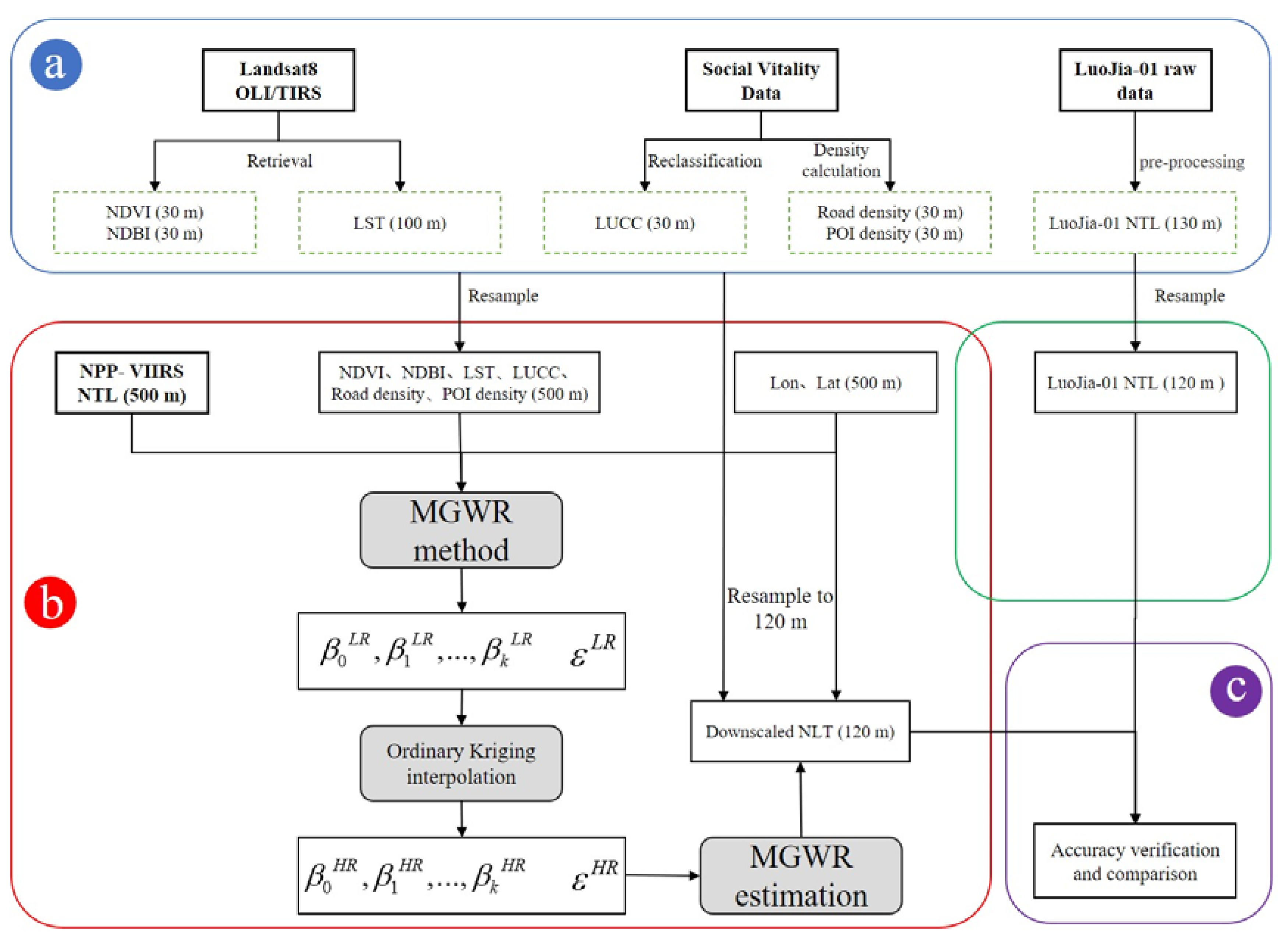
3.1. Processing Imagery
3.2. MGWR
3.3. Downscaling
- (1)
- NDVI, NDBI, road density, POI density, LUCC, LST, latitude, and longitude information were extracted at a 30-m resolution based on the Landsat 8 satellite imagery and other auxiliary data. The bilinear interpolation method was used to aggregate the spatial resolution to 120 m and 500 m;
- (2)
- MGWR was used to construct the multiscale spatial non-stationary functional relationship between NPP-VIIRS and NDVI, NDBI, road density, POI density, LUCC, LST, and the latitude and longitude information at a 500 m resolution:where is the NTL intensity estimated by the scale conversion function at the 500 m resolution scale; is the MGWR that converts the auxiliary variables to simulate NTL; , , , , , , , and are auxiliary variables at 500 m resolution;
- (3)
- Influenced by other surface physical parameters such as soil moisture, it is difficult for the selected auxiliary variables to fully reflect the spatial heterogeneity of the NTL, which is manifested as NTL residual information at low spatial resolution scales [65], which is:where is the NTL transformation residual at 500 m resolution; and are the NTL data at a 500-m resolution and the NTL data estimated by the MGWR, respectively. Assuming that the residuals are uniformly spatially distributed, we further interpolated the transformed residuals to a resolution of 120 m using ordinary kriging interpolation [66]. Ordinary kriging interpolation is a linear estimation of regionalized variables. Assuming that the data are normally distributed, the expected value of the regionalized variable is considered to be unknown, and the approximate value of the to-be-interpolated point is obtained by determining the weight of the sampling points around the to-be-interpolated point.
- (4)
- According to the ‘constant relational scale’ principle, established at low spatial resolution scales is still applicable at other spatial resolutions. Combined with the transformed residuals after spatial interpolation, the NTL data downscaled to a 120-m resolution is expressed as:where is the downscaled NTL data at a resolution of 120 m; is the MGWR function that converts the auxiliary variables to NTL data; , , , , , , , and are the 120 m resolution auxiliary variables after spatial aggregation; and is the 120 m resolution conversion residual after spatial interpolation.
3.4. Validation and Method Comparison
4. Results
4.1. Correlation Analysis of the Variables
4.2. Accuracy Evaluation of the MGWR Model
5. Discussion
5.1. Effect of MGWR Bandwidth on NTL Data Downscaling in the Study Area
5.2. Rationalization of Downscaling Based on MGWR
5.3. Application of the MGWR Model in Other Cases
5.4. Strengths and Limitations
- (1)
- The multivariate-based MGWR method better described the spatial variation of NTL data than the GWR and RF methods. The downscaled NTL images showed higher spatial resolution than the original NTL data in terms of more detailed information and sharper boundaries;
- (2)
- Due to the pronounced spatial heterogeneity scale differences of various influencing factors on the distribution of NTLs, it was difficult for global statistical regression and classical GWR models to reveal the spatial heterogeneity scale effects between the NTLs and auxiliary variables. The proposed MGWR downscaling model improved the classical GWR method by allowing individual auxiliary variables to have different bandwidth settings according to the range of influence scales. Therefore, it can provide a more realistic and effective description of the spatial process and better explain the effects of different auxiliary variables on the spatial variation of NTLs;
- (3)
- The MGWR proposed in this study mainly uses eight auxiliary variables: NDVI, NDBI, road density, POI density, LUCC, LST, latitude, and longitude, which strongly correlated with the NTL data. For the spatial downscaling of the NTLs, the construction of the relational model and the selection of the auxiliary variables were directly related to whether accurate and reliable high-spatial-resolution NTL data could be obtained. By capturing the different auxiliary variables of various auxiliary variables on the NTL distribution, MGWR avoids the introduction of excessive noise and bias in constructing the NTL conversion function and provides technical support for the accurate realization of downscaling NTL data.
- (1)
- When using remote sensing images as auxiliary data to downscale the NPP-VIIRS NTL data, the time difference between the different satellite transits will affect the downscaling accuracy. In this study, we removed the temporal error by averaging the multi-temporal Landsat 8 OLI and NPP-VIIRS NTL sensor data, although some uncertainty when predicting high-resolution NTL data may exist. When there is no auxiliary information, such as in Landsat satellite data, to perform downscaling in the study area, spatiotemporal fusion or reconstruction of corresponding auxiliary data is necessary for the spatial downscaling of NPP-VIIRS NTL data [70]. This condition increases the difficulty of the operation and may introduce some errors in data fusion or reconstruction. In the future, we will consider calibrating MGWR with more models.
- (2)
- Based on statistical regression, the downscaling process is not only considerably affected by the regression model but was also closely related to the land cover type and the state of the atmospheric environment. Therefore, to develop an NTL data downscaling model with greater applicability, selecting more study areas and periods is necessary for future testing.
6. Conclusions
Author Contributions
Funding
Conflicts of Interest
References
- Sutton, P.; Roberts, D.; Elvidge, C.; Baugh, K. Census from Heaven: An estimate of the global human population using night-time satellite imagery. Int. J. Remote Sens. 2001, 22, 3061–3076. [Google Scholar] [CrossRef]
- Xu, H.; Yang, H.; Li, X.; Jin, H.; Li, D. Multi-Scale Measurement of Regional Inequality in Mainland China during 2005–2010 Using DMSP/OLS Night Light Imagery and Population Density Grid Data. Sustainability 2015, 7, 13469–13499. [Google Scholar] [CrossRef]
- Wang, C.; Chen, Z.; Yang, C.; Li, Q.; Wu, Q.; Wu, J.; Zhang, G.; Yu, B. Analyzing parcel-level relationships between Luojia 1-01 nighttime light intensity and artificial surface features across Shanghai, China: A comparison with NPP-VIIRS data. Int. J. Appl. Earth Obs. Geoinf. 2020, 85, 101989. [Google Scholar] [CrossRef]
- Yu, B.; Lian, T.; Huang, Y.; Yao, S.; Ye, X.; Chen, Z.; Yang, C.; Wu, J. Integration of nighttime light remote sensing images and taxi GPS tracking data for population surface enhancement. Int. J. Geogr. Inf. Sci. 2019, 33, 687–706. [Google Scholar] [CrossRef]
- Shi, K.; Huang, C.; Yu, B.; Yin, B.; Huang, Y.; Wu, J. Evaluation of NPP-VIIRS night-time light composite data for extracting built-up urban areas. Remote Sens. Lett. 2014, 5, 358–366. [Google Scholar] [CrossRef]
- Chen, Z.; Yu, B.; Zhou, Y.; Liu, H.; Yang, C.; Shi, K.; Wu, J. Mapping Global Urban Areas From 2000 to 2012 Using Time-Series Nighttime Light Data and MODIS Products. IEEE J. Sel. Top. Appl. Earth Obs. Remote Sens. 2019, 12, 1143–1153. [Google Scholar] [CrossRef]
- Li, Y.; Song, Z.; Wu, B.; Yu, B.; Wu, Q.; Hong, Y.; Liu, S.; Wu, J. Evaluating the Ability of NOAA-20 Monthly Composite Data for Socioeconomic Indicators Estimation and Urban Area Extraction. IEEE J. Sel. Top. Appl. Earth Obs. Remote Sens. 2022, 15, 1837–1845. [Google Scholar] [CrossRef]
- Yu, B.; Tang, M.; Wu, Q.; Yang, C.; Deng, S.; Shi, K.; Peng, C.; Wu, J.; Chen, Z. Urban Built-Up Area Extraction From Log- Transformed NPP-VIIRS Nighttime Light Composite Data. IEEE Geosci. Remote Sens. Lett. 2018, 15, 1279–1283. [Google Scholar] [CrossRef]
- Chen, Z.; Yu, B.; Hu, Y.; Huang, C.; Shi, K.; Wu, J. Estimating House Vacancy Rate in Metropolitan Areas Using NPP-VIIRS Nighttime Light Composite Data. IEEE J. Sel. Top. Appl. Earth Obs. Remote Sens. 2015, 8, 2188–2197. [Google Scholar] [CrossRef]
- Lu, H.; Zhang, C.; Liu, G.; Ye, X.; Miao, C. Mapping China’s Ghost Cities through the Combination of Nighttime Satellite Data and Daytime Satellite Data. Remote Sens. 2018, 10, 1037. [Google Scholar] [CrossRef]
- Chen, Z.; Yu, B.; Song, W.; Liu, H.; Wu, Q.; Shi, K.; Wu, J. A New Approach for Detecting Urban Centers and Their Spatial Structure with Nighttime Light Remote Sensing. IEEE Trans. Geosci. Remote Sens. 2017, 55, 6305–6319. [Google Scholar] [CrossRef]
- Wu, B.; Yu, B.; Yao, S.; Wu, Q.; Chen, Z.; Wu, J. A surface network based method for studying urban hierarchies by night time light remote sensing data. Int. J. Geogr. Inf. Sci. 2019, 33, 1377–1398. [Google Scholar] [CrossRef]
- Cheng, B.; Chen, Z.; Yu, B.; Li, Q.; Wang, C.; Li, B.; Wu, B.; Li, Y.; Wu, J. Automated Extraction of Street Lights from JL1-3B Nighttime Light Data and Assessment of Their Solar Energy Potential. IEEE J. Sel. Top. Appl. Earth Obs. Remote Sens. 2020, 13, 675–684. [Google Scholar] [CrossRef]
- Ou, J.; Liu, X.; Liu, P.; Liu, X. Evaluation of Luojia 1-01 nighttime light imagery for impervious surface detection: A comparison with NPP-VIIRS nighttime light data. Int. J. Appl. Earth Obs. Geoinf. 2019, 81, 1–12. [Google Scholar] [CrossRef]
- Guo, W.; Zhang, Y.; Gao, L. Using VIIRS-DNB and landsat data for impervious surface area mapping in an arid/semiarid region. Remote Sens. Lett. 2018, 9, 587–596. [Google Scholar] [CrossRef]
- Guo, W.; Lu, D.; Wu, Y.; Zhang, J. Mapping Impervious Surface Distribution with Integration of Snnp Viirs-NDB Modis Ndvi Data. Remote Sens. 2015, 7, 12459–12477. [Google Scholar] [CrossRef]
- Baugh, K.; Hsu, F.-C.; Elvidge, C.D.; Zhizhin, M. Nighttime Lights Compositing Using the VIIRS Day-Night Band: Preliminary Results. Proc. Asia-Pac. Adv. Netw. 2013, 35, 70. [Google Scholar] [CrossRef]
- Zhang, G.; Li, L.; Jiang, Y.; Shen, X.; Li, D. On-orbit relative radiometric calibration of the night-time sensor of the luojia1-01 satellite. Sensors 2018, 18, 4225. [Google Scholar] [CrossRef]
- Zheng, Q.; Weng, Q.; Huang, L.; Wang, K.; Deng, J.; Jiang, R.; Ye, Z.; Gan, M. A new source of multi-spectral high spatial resolution night-time light imagery—JL1-3B. Remote Sens. Environ. 2018, 215, 300–312. [Google Scholar] [CrossRef]
- Huang, B.; Zhao, Y. Resrarch Status and Prospect of Spatio temporal Fusion of Multi-source Satellite Remote Sensing Imagery. Acta Geod. Et Cartogr. Sin. 2017, 46, 1492–1499. [Google Scholar] [CrossRef]
- Luo, X.; Chen, Y.; Wang, Z.; Li, H.; Peng, Y. Spatial down-scaling of land surface temperature based on MODIS data. Chin. J. Ecol. 2016, 35, 3443–3450. [Google Scholar] [CrossRef]
- Wang, Z.; Qin, Q.; Sun, Y.; Zhang, T.; Ren, H. Downscaling remotely sensed land surface temperature with the BP neural network. Remote Sens. Technol. Appl. 2018, 33, 793–802. [Google Scholar] [CrossRef]
- Gao, F.; Masek, J.; Schwaller, M.; Hall, F. On the blending of the Landsat and MODIS surface reflectance: Predicting daily Landsat surface reflectance. IEEE Trans. Geosci. Remote Sens. 2006, 44, 2207–2218. [Google Scholar] [CrossRef]
- Zhang, B.; Zhang, L.; Xie, D.; Yin, X.; Liu, C.; Liu, G. Application of synthetic NDVI time series blended from Landsat and MODIS data for grassland biomass estimation. Remote Sens. 2016, 8, 10. [Google Scholar] [CrossRef]
- Hilker, T.; Wulder, M.A.; Coops, N.C.; Linke, J.; McDermid, G.; Masek, J.; Gao, F.; White, J.C. A new data fusion model for high spatial and temporal-resolution mapping of forest disturbance based on Landsat and MODIS. Remote Sens. Environ. 2009, 113, 1613–1627. [Google Scholar] [CrossRef]
- Liu, M.; Yang, W.; Zhu, X.L.; Chen, J.; Chen, X.H.; Yang, L.Q.; Helmer, E.H.; Huang, B.; Song, H. An Improved Flexible Spatiotemporal DAta Fusion (IFS-DAF) method for producing high spatiotemporal resolution normalized difference vegetation index time series. Remote Sens. Environ. 2019, 227, 74–89. [Google Scholar] [CrossRef]
- Shi, C.; Wang, X.; Zhang, M.; Liang, X.; Niu, L.; Han, H.; Zhu, X. A comprehensive and automated fusion method: The enhanced flexible spatiotemporal DAta fusion model for monitoring dynamic changes of land surface. Appl. Sci. 2019, 9, 3693. [Google Scholar] [CrossRef]
- Huang, B.; Jiang, X.L. An enhanced unmixing model for spatiotemporal image fusion. Natl. Remote Sens. Bull. 2021, 25, 241–250. [Google Scholar] [CrossRef]
- Zhan, W.; Chen, Y.; Zhou, J.; Li, J.; Liu, W.Y. Sharpening thermal imageries: A generalized theoretical framework from an assimilation perspective. IEEE Trans. Geosci. Remote Sens. 2011, 49, 773–789. [Google Scholar] [CrossRef]
- Dowman, I.R.; Hannes, I. Global geospatial data from Earth observation: Status and issues. Int. J. Digit. Earth 2016, 10, 328–341. [Google Scholar] [CrossRef]
- Guo, N.; Wang, X. Advances and developing opportunities in remote sensing of drought. J. Arid. Meteorol. 2015, 33, 1–18. [Google Scholar]
- Yang, Q.; Yuan, Q.; Li, T.; Yue, L. Mapping PM2.5 concentration at high resolution using a cascade random forest based downscaling model: Evaluation and application. J. Clean. Prod. 2020, 277, 123887. [Google Scholar] [CrossRef]
- Chen, C.; Zhao, S.; Duan, Z.; Qin, Z. An Improved Spatial Downscaling Procedure for TRMM 3B43 Precipitation Product Using Geographically Weighted Regression. IEEE J. Sel. Top. Appl. Earth Obs. Remote Sens. 2015, 8, 4592–4604. [Google Scholar] [CrossRef]
- Kustas, W.P.; Norman, J.M.; Anderson, M.C.; French, A.N. Estimating subpixel surface temperatures and energy fluxes from thevegetation index–radiometric temperature relationship. Remote Sens. Environ. 2003, 85, 429–440. [Google Scholar] [CrossRef]
- Agam, N.; Kustas, W.P.; Anderson, M.C.; Li, F.Q.; Neale, C.M.U. A vegetation index based technique for spatial sharpening of thermal imagery. Remote Sens. Environ. 2007, 107, 545–558. [Google Scholar] [CrossRef]
- Dominguez, A.; Kleiss, L.J.; Luvall, J.C.; Rickman, D.L. High-resolution urban thermal sharpener (HUTS). Remote Sens. Environ. 2011, 115, 1772–1780. [Google Scholar] [CrossRef]
- Zhu, S.; Guan, H.; Millington, A.C.; Zhang, G. Disaggre-gation of land surface temperature over a heterogeneous urban and surrounding suburban area: A case study in Shanghai. Int. J. Remote Sens. 2013, 34, 1707–1723. [Google Scholar] [CrossRef]
- Chen, Z.; Yu, B.; Yang, C.; Zhou, Y.; Yao, S.; Qian, X.; Wang, C.; Wu, B.; Wu, J. An extended time series (2000–2018) of global NPP-VIIRS-like nighttime light data from a cross-sensor calibration. Earth Syst. Sci. Data 2021, 13, 889–906. [Google Scholar] [CrossRef]
- Ye, Y.; Huang, L.; Zheng, Q.; Liang, C.; Dong, B.; Deng, J.; Han, X. A feasible framework to downscale NPP-VIIRS nighttime light imagery using multi-source spatial variables and geographically weighted regression. Int. J. Appl. Earth Obs. Geoinf. 2021, 104, 102513. [Google Scholar] [CrossRef]
- Fotheringham, S.; Yang, W.; Kang, W. Multiscale geographically weighted regression (MGWR). Ann. Am. Assoc. Geogr. 2017, 107, 1247–1265. [Google Scholar] [CrossRef]
- Shen, T.Y.; Yu, H.C.; Zhou, L.; Gu, H.Y.; He, H.H. On hedonic price of second-hand houses in Beijing based on multi-scale geo-graphically weighted regression: Scale law of spatial heterogeneity. Econ. Geogr. 2020, 40, 75–83. [Google Scholar] [CrossRef]
- Levin, N.; Johansen, K.; Hacker, J.M.; Phinn, S. A new source for high spatial resolution night time images—The EROS-B commercial satellite. Remote Sens. Environ. 2014, 149, 1–12. [Google Scholar] [CrossRef]
- Scher, C.L.; Karimi, N.; Glasenhardt, M.C.; Tuffin, A.; Cannon, C.H.; Scharenbroch, B.C.; Hipp, A.L. Application of remote sensing technology to estimate productivity and assess phylogenetic heritability. Appl. Plant Sci. 2020, 8, e11401. [Google Scholar] [CrossRef] [PubMed]
- Davis, A.Y.; Jung, J.; Pijanowski, B.C.; Minor, E.S. Combined vegetation volume and “greenness” affect urban air temperature. Appl. Geogr. 2016, 71, 106–114. [Google Scholar] [CrossRef]
- Li, F.; Yan, Q.; Bian, Z.; Liu, B.; Wu, Z. A poi and lst adjusted ntl urban index for urban built-up area extraction. Sensors 2020, 20, 2918. [Google Scholar] [CrossRef]
- Zhao, N.; Cao, G.; Zhang, W.; Samson, E.L.; Chen, Y. Remote sensing and social sensing for socioeconomic systems: A comparison study between nighttime lights and location-based social media at the 500 m spatial resolution. Int. J. Appl. Earth Obs. Geoinf. 2020, 87, 102058. [Google Scholar] [CrossRef]
- Levin, N.; Duke, Y. High spatial resolution night-time light images for demographic and socio-economic studies. Remote Sens. Environ. 2012, 119, 1–10. [Google Scholar] [CrossRef]
- Yu, H.; Fotheringham, A.S.; Li, Z.; Oshan, T.; Kang, W.; Wolf, L. Inference in multiscale geographically weighted regression. Geogr. Anal. 2019, 52, 87–106. [Google Scholar] [CrossRef]
- Zhu, X.M.; Song, X.N.; Leng, P.; Hu, R.H. Spatial downscaling of land surface temperature with the multi-scale geographically weighted regression. Natl. Remote Sens. Bull. 2021, 25, 1749–1766. [Google Scholar] [CrossRef]
- Sun, Y.; Wang, S.; Wang, Y. Estimating local-scale urban heat island intensity using nighttime light satellite imageries. Sustain. Cities Soc. 2020, 57, 102125. [Google Scholar] [CrossRef]
- Li, H.; Zhang, H.; Wang, M. A Comparative Study of Population Spatialization Based on NPP/VIIRS and LJ1-01 Night Data: Taking Beijing for an Example. Remote Sens. Inf. 2021, 36, 90–97. [Google Scholar] [CrossRef]
- Xu, J.; Wang, J.; Xiong, N.; Chen, Y.; Sun, L.; Wang, Y.; An, L. Analysis of Ecological Blockage Pattern in Beijing Important Ecological Function Area, China. Remote Sens. 2022, 14, 1151. [Google Scholar] [CrossRef]
- Elvidge, C.D.; Zhizhin, M.; Ghosh, T.; Hsu, F.-C.; Taneja, J. Annual Time Series of Global VIIRS Nighttime Lights Derived from Monthly Averages: 2012 to 2019. Remote Sens. 2021, 13, 922. [Google Scholar] [CrossRef]
- Elvidge, C.; Baugh, K.; Zhizhin, M.; Hsu, F.-C. Why VIIRS data are superior to DMSP for mapping nighttime lights. Proc. Asia-Pac. Adv. Netw. 2013, 35, 62–69. [Google Scholar] [CrossRef]
- Wang, Z.; Román, M.O.; Kalb, V.L.; Miller, S.D.; Zhang, J.; Shrestha, R.M. Quantifying uncertainties in nighttime light retrievals from Suomi-NPP and NOAA-20 VIIRS Day/Night Band data. Remote Sens. Environ. 2021, 263, 112557. [Google Scholar] [CrossRef]
- Wang, L.; Fan, H.; Wang, Y. Improving population mapping using Luojia 1–01 nighttime light image and location-based social media data. Total Env. 2020, 730, 139–148. [Google Scholar] [CrossRef]
- Ye, Y.; Xue, X.; Huang, L.; Gan, M.; Tong, C.; Wang, K.E.; Deng, J. A new persective to map the supply and demand of artificial night light based on Loujia1- 01 and urban big data. Clean. Prod 2020, 276, 123–244. [Google Scholar] [CrossRef]
- Foga, S.; Scaramuzza, P.L.; Guo, S.; Zhu, Z.; Dilley, R.D.; Beckmann, T.; Schmidt, G.L.; Dwyer, J.L.; Joseph Hughes, M.; Laue, B. Cloud detection algorithm comparison and validation for operational Landsat data products. Remote Sens. Environ. 2017, 194, 379–390. [Google Scholar] [CrossRef]
- Gao, P.W.; Kasim, A.; Ruzi, T.; Zhao, M.C. Temporal and spatial analysis of ecological environment improvement in Hami City. Arid Zone Res. 2020, 37, 1057–1067. [Google Scholar]
- Singh, A.K.; Toshniwal, D. A Big Data Approach for Situation-Aware correction and estimation of NDVI, based on Landsat8 OLI/TIRS (Surface Reflectance) time series data. Jpn. Geosci. Union. 2017. Available online: https://ui.adsabs.harvard.edu/abs/2017AGUFM.A41H2392S (accessed on 10 August 2022).
- Vermote, E.; Justice, C.; Claverie, M.; Franch, B. Preliminary analysis of the performance of the Landsat 8/OLI land surface reflectance product. Remote Sens. Environ. 2016, 185, 46–56. [Google Scholar] [CrossRef]
- Qi, J.; Li, X. Research on Retrieval of Surface Temperature Based on Landsat8 Data Atmospheric Correction Method. In Proceedings of the JpGU-AGU Joint Meeting, Chiba, Japan, 20–25 May 2017. [Google Scholar]
- Li, X.; Zhao, L.; Li, D.; Xu, H. Mapping Urban Extent Using Luojia 1–01 Nighttime Light Imagery. Sensors 2018, 18, 3665. [Google Scholar] [CrossRef] [PubMed]
- Oshan, T.M.; Li, Z.; Kang, W.; Wolf, L.J.; Fotheringham, A.S. mgwr: A Python Implementation of Multiscale Geographically Weighted Regression for Investigating Process Spatial Heterogeneity and Scale. ISPRS Int. J. Geo-Inf. 2019, 8, 269. [Google Scholar] [CrossRef]
- Mukherjee, S.; Joshi, P.K.; Garg, R.D. A comparison of different regression models for downscaling Landsat and MODIS land surface temperature images over heterogeneous landscape. Adv. Space Res. 2014, 54, 655–669. [Google Scholar] [CrossRef]
- Li, Y.; Baorong, Z.; Xiaohong, X.; Zijun, L. Application of a semivariogram based on a deep neural network to Ordinary Kriging interpolation of elevation data. PLoS ONE 2022, 17, e0266942. [Google Scholar] [CrossRef] [PubMed]
- Guo, B.; Bian, Y.; Zhang, D.; Su, Y.; Wang, X.; Zhang, B.; Wang, Y.; Chen, Q.; Wu, Y.; Luo, P. Estimating Socio-Economic Parameters via Machine Learning Methods Using Luojia1-01 Nighttime Light Remotely Sensed Images at Multiple Scales of China in 2018. IEEE Access 2021, 9, 34352–34365. [Google Scholar] [CrossRef]
- Zhan, W.; Chen, Y.; Wang, J.; Zhou, J.; Quan, J.; Liu, W.; Li, J. Downscaling land surface temperatures with multi-spectral and multi-resolution images. Int. J. Appl. Earth Obs. Geoinf. 2012, 18, 23–36. [Google Scholar] [CrossRef]
- Hutengs, C.; Vohland, M. Downscaling land surface temperatures at regional scales with random forest regression. Remote Sens. Environ. 2016, 178, 127–141. [Google Scholar] [CrossRef]
- Wang, J.; Huang, B. A rigorously-weighted spatio temporal fusion model with uncertainty analysis. Remote Sens. 2017, 9, 990. [Google Scholar] [CrossRef]
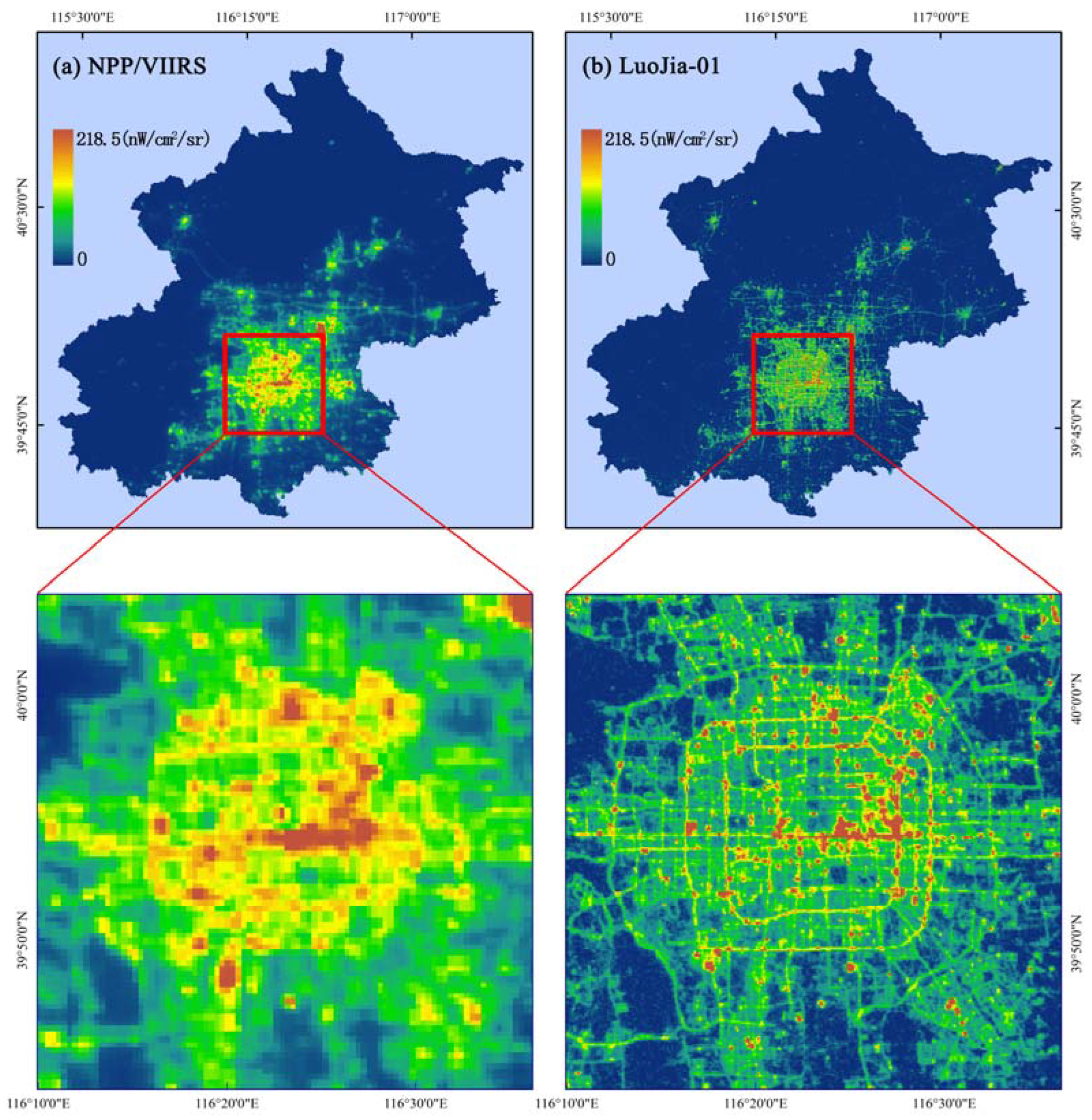

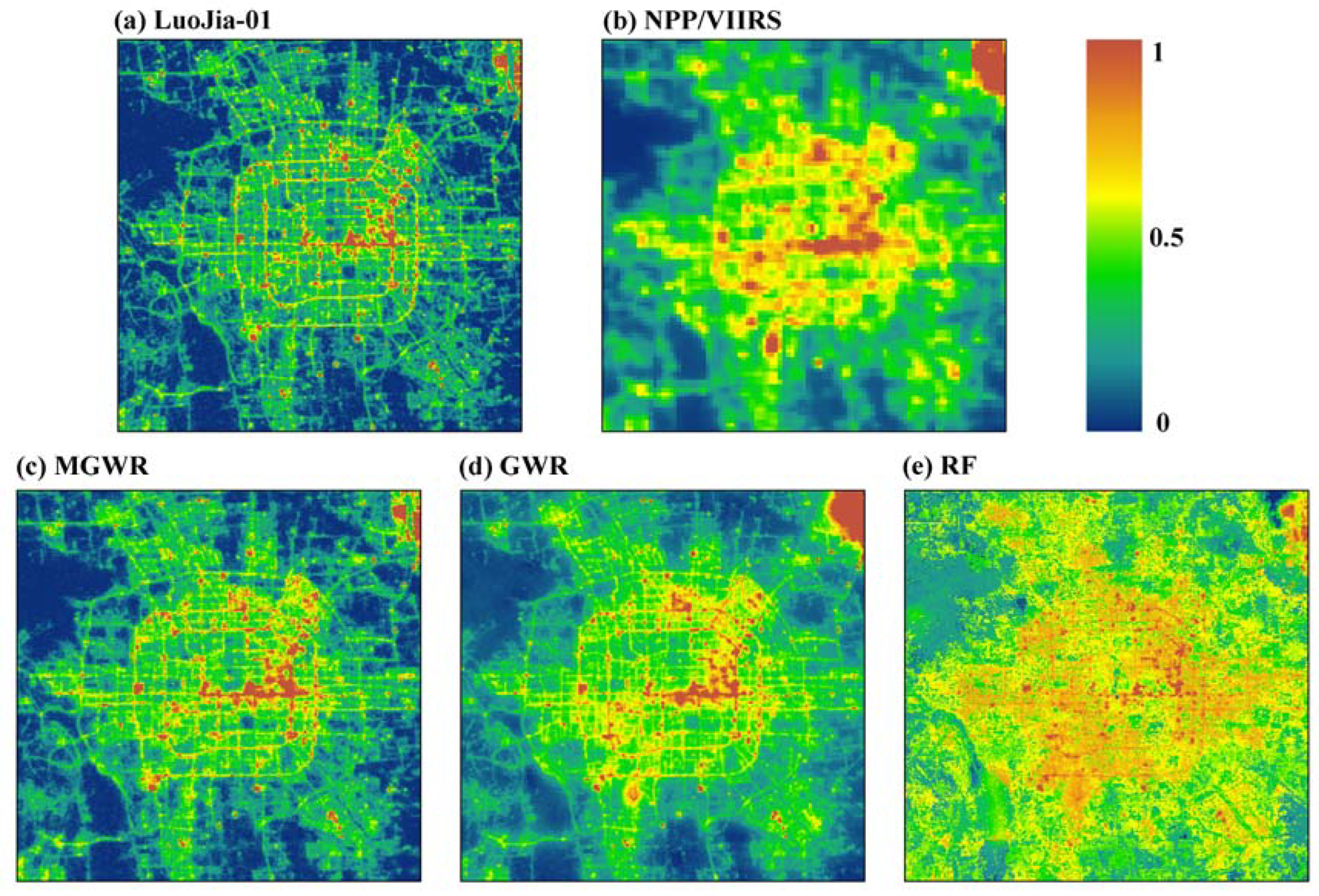
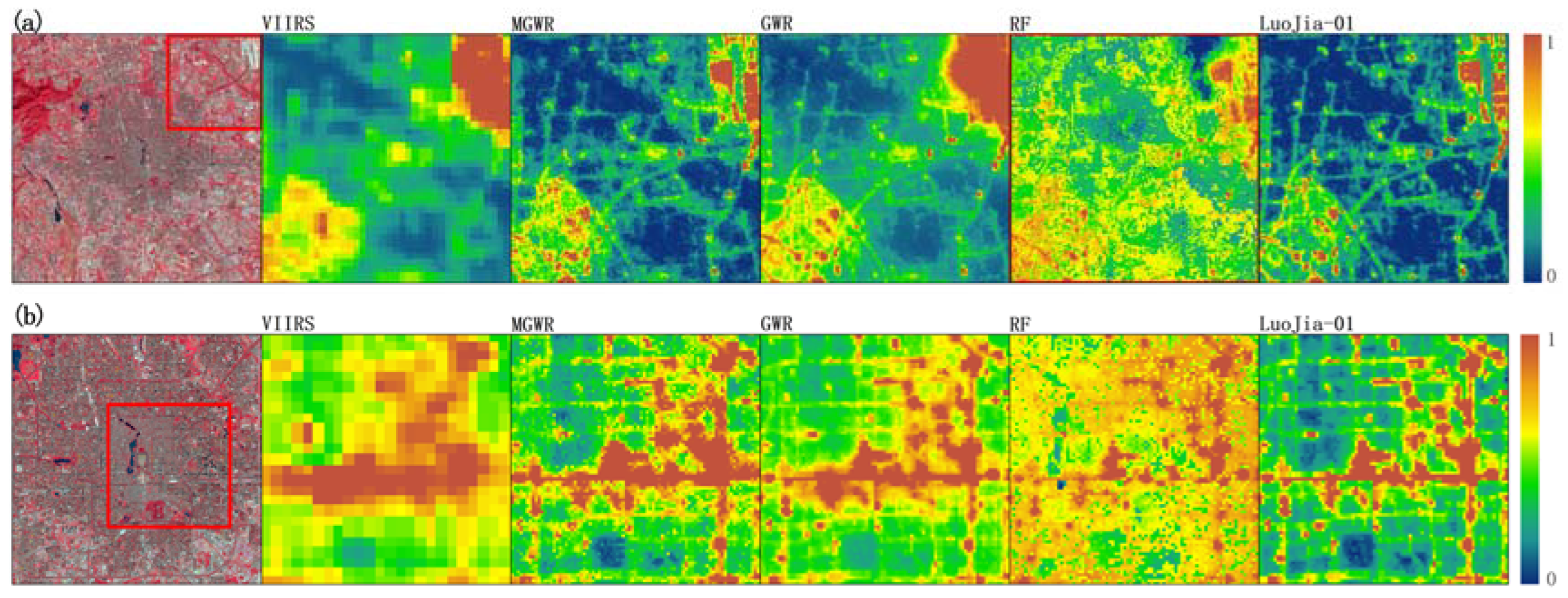
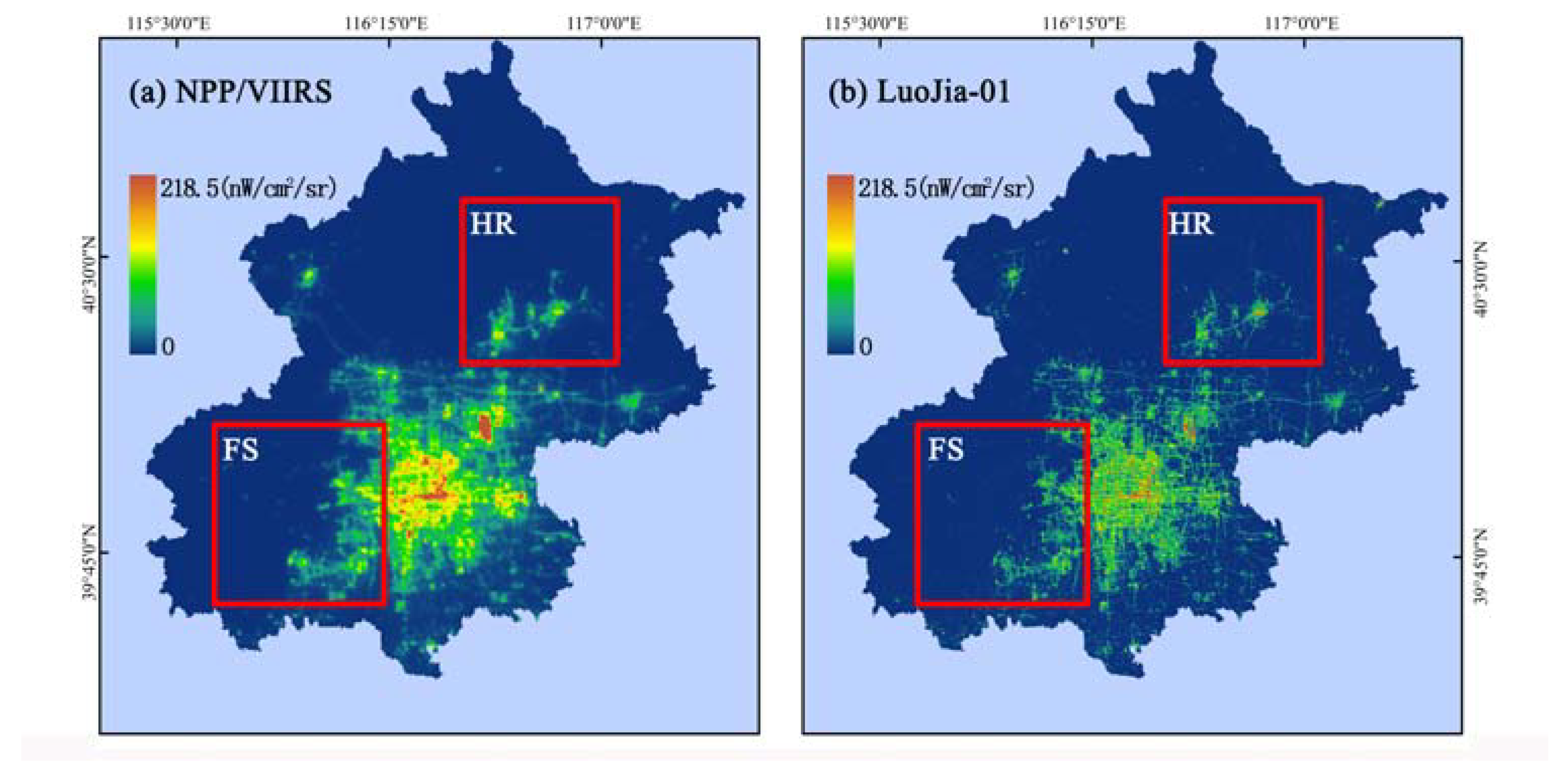
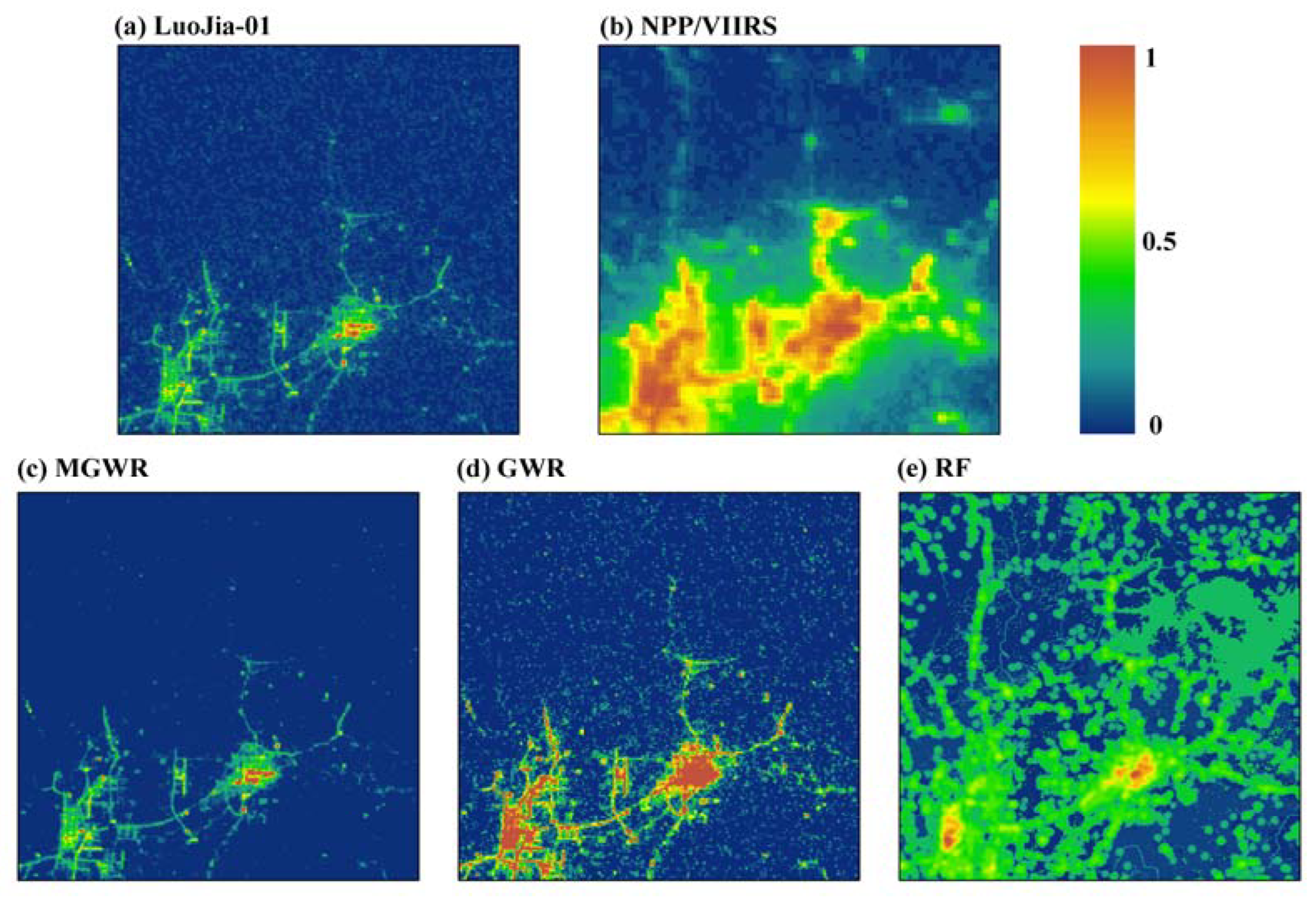
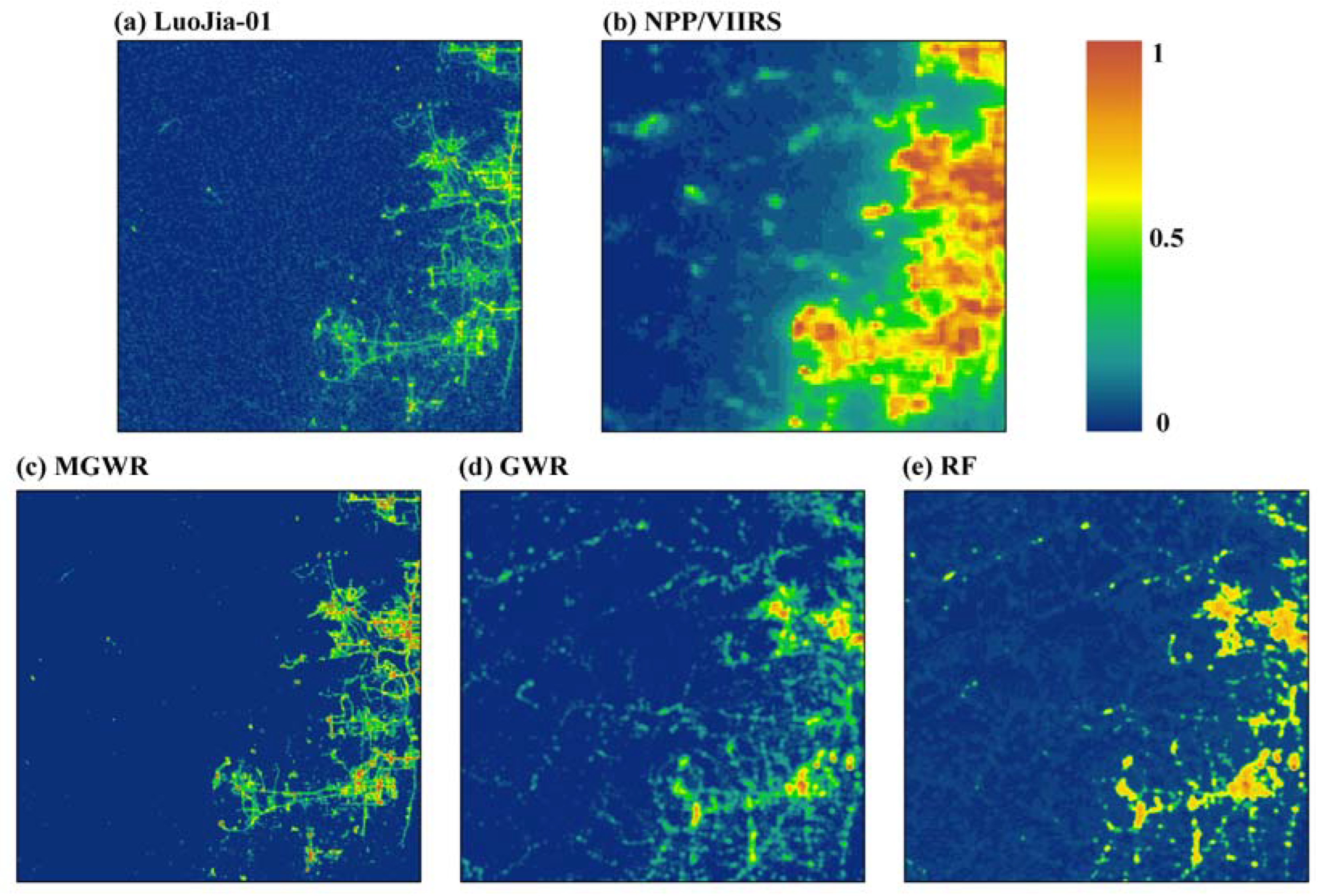
| Remote Sensing Platform | Available Time | Data Products | Spatial Resolution (m) | Temporal Resolution |
|---|---|---|---|---|
| DMSP-OLS | 1992–2013 | Stable lights | ~1000 | 1 year |
| NPP-VIIRS | April 2012–present | Monthly cloud-free composites | 500 | 1 month |
| 19 January 2012–present | Nightly mosaics | 750 | 1 day | |
| EROS-B | 2013–present | Raw data | 0.7 | ordering |
| JL1-3B | January 2017–present | Raw data | 0.92 | ordering |
| LuoJia1-01 | June 2018–2019 | Raw data | ~130 | 15 days |
| Data Type | Data Acquisition Time | Spatial Resolution (m) | Wavelengths (μm) | Data Format |
|---|---|---|---|---|
| Landsat 8 OLI Landsat 8 TIRS | August–September 2018 | 30 100 | 0.43–1.38 10.60–12.51 | GeoTIFF |
| NPP-VIIRS Monthly cloud-free DNB composite | September 2018 | 500 | 0.5–0.9 | GeoTIFF |
| LuoJia1-01 | September 2018 | 130 | 0.46–0.98 | GeoTIFF |
| LUCC | 2018 | 30 | / | GeoTIFF |
| Road density | September 2018 | 120 | / | GeoTIFF |
| POI | September 2018 | / | / | ShapeFile |
| Auxiliary Variables | NDVI | NDBI | LUCC | Road Density | POI Density | LST | Intercept |
|---|---|---|---|---|---|---|---|
| PCC | −0.27 | −0.12 | 0.17 | 0.28 | 0.29 | 0.15 | / |
| Mean | −0.951 | −0.023 | −0.004 | 0.070 | 0.387 | 0.023 | 2.148 |
| STD | −0.153 | 0.012 | 0.025 | 0.096 | 0.358 | 0.142 | 0.598 |
| Min | −2.086 | −0.052 | −0.135 | −0.350 | −1.219 | −0.517 | 0.857 |
| Median | −1.036 | −0.025 | −0.001 | 0.059 | 0.306 | 0.012 | 2.039 |
| Max | −0.028 | −0.003 | 0.065 | 0.912 | 2.474 | 1.705 | 4.240 |
| Auxiliary Variables | NDVI | NDBI | LUCC | Road Density | POI Density | LST | Intercept |
|---|---|---|---|---|---|---|---|
| MGWR bandwidth | 43 | 707 | 558 | 48 | 43 | 50 | 43 |
| GWR bandwidth | 70 | 70 | 70 | 70 | 70 | 70 | 70 |
| Spatial Resolution (m) | All Image Pixels | Central City Pixels | ||
|---|---|---|---|---|
| Coefficient | Intercept | Coefficient | Intercept | |
| 120 m | 28.16 | 72.67 | 20.66 | 363.23 |
| 240 m | 26.58 | 78.22 | 20.50 | 367.57 |
| 360 m | 26.25 | 80.13 | 20.42 | 371.24 |
| 480 m | 26.22 | 80.19 | 20.32 | 379.28 |
| 600 m | 24.74 | 83.68 | 19.35 | 384.42 |
Publisher’s Note: MDPI stays neutral with regard to jurisdictional claims in published maps and institutional affiliations. |
© 2022 by the authors. Licensee MDPI, Basel, Switzerland. This article is an open access article distributed under the terms and conditions of the Creative Commons Attribution (CC BY) license (https://creativecommons.org/licenses/by/4.0/).
Share and Cite
Liu, S.; Zhao, X.; Zhang, F.; Qiu, A.; Chen, L.; Huang, J.; Chen, S.; Zhang, S. Spatial Downscaling of NPP-VIIRS Nighttime Light Data Using Multiscale Geographically Weighted Regression and Multi-Source Variables. Remote Sens. 2022, 14, 6400. https://doi.org/10.3390/rs14246400
Liu S, Zhao X, Zhang F, Qiu A, Chen L, Huang J, Chen S, Zhang S. Spatial Downscaling of NPP-VIIRS Nighttime Light Data Using Multiscale Geographically Weighted Regression and Multi-Source Variables. Remote Sensing. 2022; 14(24):6400. https://doi.org/10.3390/rs14246400
Chicago/Turabian StyleLiu, Shangqin, Xizhi Zhao, Fuhao Zhang, Agen Qiu, Liujia Chen, Jing Huang, Song Chen, and Shu Zhang. 2022. "Spatial Downscaling of NPP-VIIRS Nighttime Light Data Using Multiscale Geographically Weighted Regression and Multi-Source Variables" Remote Sensing 14, no. 24: 6400. https://doi.org/10.3390/rs14246400
APA StyleLiu, S., Zhao, X., Zhang, F., Qiu, A., Chen, L., Huang, J., Chen, S., & Zhang, S. (2022). Spatial Downscaling of NPP-VIIRS Nighttime Light Data Using Multiscale Geographically Weighted Regression and Multi-Source Variables. Remote Sensing, 14(24), 6400. https://doi.org/10.3390/rs14246400









